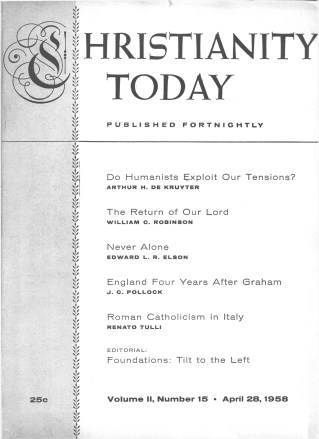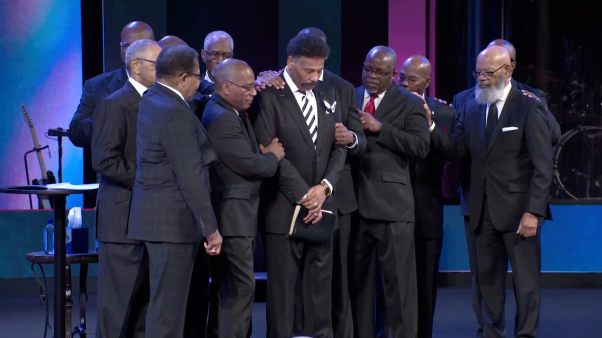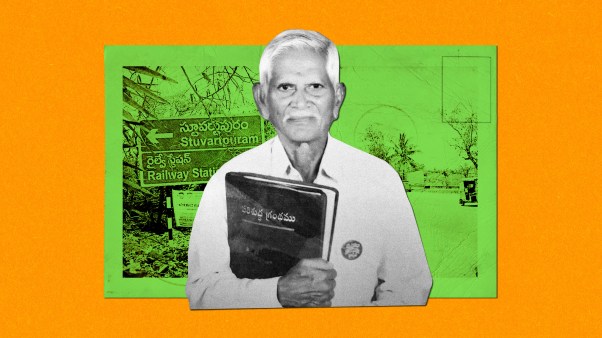A distinctive feature of Seventh-day Adventist teaching is the “heavenly sanctuary” doctrine. On the day after “the great disappointment” in 1844, Hiram Edson assertedly experienced a vision of heaven in which he saw Christ, the High Priest, entering the most holy place in heaven to cleanse it. Here then, of course, lay the readiest explanation for the failure of Christ to return to earth as had been expected by the Adventists.
What was the purpose of this supposed cleansing of the sanctuary in 1844? To learn this, the Adventists turned to the biblical account of the yearly day of Atonement, and found there, presumably in type, the explanation of this new phase of the ministry of Christ in behalf of sinners.
A passage from Mrs. White’s writings, reprinted by the Seventh-day Adventists in 1947, summarizes the meaning of this doctrine:
As the sins of the people were anciently transferred, in figure, to the earthly sanctuary by the blood of the sin offering, so our sins are, in fact, transferred to the heavenly sanctuary by the blood of Christ. And as the typical cleansing of the earthly was accomplished by the removal of the sins by which it had been polluted, so the actual cleansing of the heavenly is to be accomplished by the removal, or blotting out of the sins which are there recorded. This necessitates an examination of the books of record to determine who, through repentance of sin and faith in Christ, are entitled to the benefits of his atonement. The cleansing of the sanctuary, therefore, involves a work of investigative judgment. This work must be performed prior to the coming of Christ to redeem his people, for when he comes, his reward is with him to give to every man according to his works.
The Need For Buttressing
This passage is neither out of context nor unrepresentative of Adventist thought. Several matters here require attention. Something might well be said respecting the Adventist view of the time of Christ’s entering the most holy place. The New Testament informs us that in connection with his atoning work at Calvary, Christ entered once for all into heaven itself, now to appear in the presence of God for us, and a reading of the book of Hebrews alone ought to make this clear enough. It might be urged too that this whole system has based an idea of the Atonement around a precarious interpretation of a difficult prophetic theme, rather than deriving it from a treatment of those passages of Scripture which deal explicitly with the subject—certainly a most unfortunate way of dealing with the Bible. Lacking a special theory of this kind, who would ever have thought of understanding the Scriptures to teach that Christ “in 1844 entered the 2nd apartment of the heavenly sanctuary, and that he had a work to perform in the most holy before coming to this earth”?
The Investigative Judgment
But, most important, we must ask just what, in the Adventist view, is Christ doing in the most holy place in heaven? He is carrying on what is described as the investigative judgment, the purpose of which is to determine who, from among those sinners whose sins have been forgiven by faith in him, are entitled to the benefits of his atonement, and thus have their sins finally blotted out. The question that interests us here is, who are shown to be entitled to the benefits of the atoning work of Christ? The answer to this question is found in the writings of Mrs. White, who was assertedly given prophetic insight into these matters. This passage is also quoted in Questions on Doctrine, latest publication of the Adventists explaining their views to the public.
All who have truly repented of sin, it says, and by faith claimed the blood of Christ as their atoning sacrifice have had pardon entered against their names in the books of heaven. “As they have become partakers of the righteousness of Christ, and their characters are found to be in harmony with the law of God, their sins will be blotted out, and they themselves accounted worthy of eternal life.”
Now it must be emphasized that the Adventists do not say that salvation is through keeping the Commandments. In their view it is not possible for a sinner in his own strength to reach the stage where his character is found to be entirely in harmony with the Law of God. The situation is rather that Christ imparts his character to believers, as they allow him to, keeping the Law in and through them, that they may be found acceptable in the great assize. Moreover, the Adventists do not teach that any believer will keep the Law perfectly; continual cleansing from sin is necessary and is provided for; in their words, “When the name of a true child of God comes up in the judgment the record will reveal that every sin has been confessed”—that in itself, as Martin Luther would testify, is a large order—“that every sin has been confessed and has been forgiven.”
The Crucial Point
When we have given full weight to these reservations, however, it remains true that at the crucial point, the point at which the destiny of the sinner is forever settled, the righteousness of Christ is not the sole ground of his hope; it is the righteousness of Christ and, in some measure, his character which is the basis of his acceptance. Thus, at that moment when, in the view of Adventism, life and death hang in the balance, the appropriate word is not, after all, “Nothing in my hand I bring, simply to thy cross I cling.” For in Adventism at least one stitch in the saint’s celestial garment shall be of his own making. And if it is thus, then grace is no more grace.
Legalism And The Law
This brings us to the question of legalism. In the various books and pamphlets which oppose the Seventh-day Adventist movement, a prominent note is criticism of their legalism. That Adventism has elements of what is undoubtedly a real legalism, by which is meant that there is the note of salvation by character, has, I think, been demonstrated. It is also true that they are legalistic in the sense that they presume to legislate the details of Christian conduct beyond what the Scriptures require. An Adventist, for example, must not only forego the use of alcohol and tobacco, but is forbidden, under penalty of sin, to indulge in tea, coffee, ham, shrimp, lobster, clams, oysters, snails. Much of the anti-Adventist polemic, however, takes them to task for something which is not legalism at all, namely, for their affirmation of the perpetual and universal validity of the moral law as the standard of conduct which is pleasing to God. It is most distressing to read in Eternity magazine statements such as “[The Adventists] take a position, [to us very illogical] that the Ten Commandments are to be obeyed.…” But that Adventists so believe is no reason for barring them from evangelical fellowship. For it is not their honoring of the Law, but their wrong use of the Law, which constitutes their fatal error in understanding the way of life.
The Sabbath Question
Again, what of this matter of the Sabbath? In Adventism this question, of course, looms large. As worked out in the early days of the movement by Edson and Bates, afterwards with the help of the Whites, the “history” of it is that originally the Christian Church kept the seventh-day Sabbath. All too soon, however, the Church was corrupted from its primitive purity and, along with the rise of the papacy, a false Sunday sacredness came to be accepted. At last, during the reign of Constantine, Sunday was established by civil law as the Sabbath day. Thus for some 1500 years, the Church manifested its apostasy by keeping Sunday. Even the Reformers of the sixteenth century unwittingly gave the Pope his due by failing to recognize that the seventh day is the Sabbath.
With the beginning of this new phase of the ministry of Christ in the heavenly temple, however, the Church was to be recalled to obedience to the Commandments. Indeed, Mrs. White herself reported that she had been given a look inside the heavenly ark of the covenant, where the originals of the two tables of the Law are kept, and the Fourth Commandment appeared to glow more brightly than the others. This vision of course, did not originate the doctrine; as always, it simply “confirmed” it and pointed out erroneous ideas. The “real basis” for this teaching is found in the Bible; for the Fourth Commandment says that the seventh day is the Sabbath, and, further, the message of the third angel of Revelation 14, who, along with the other two are manifestly intended to describe the several phases of the Adventist movement, speaks of the “mark of the Beast” which again, by every “sound rule” of exegesis, is to be equated with worship on the first day. Thus the Seventh-day Adventists, being a commandment-keeping people, are the “real” remnant church and the rest of Christendom is Babylon. It is to be marked well, I realize, that Adventists acknowledge there are true believers in the apostate churches; not all have come to understand that by honoring the first day they are breaking the commandment; moreover, no one has yet received the mark because the Sunday Sabbath has not yet been made the universal law. (Perhaps the observation is unnecessary that it is small comfort to be told that what one does is the same thing as having the mark of the beast, but that as yet it has not been ineradicably graven on his forehead.)
Learning From Adventism
I am convinced that any approach to this movement which views it as just another evangelical denomination is mistaken, and cannot help but bring about greater confusion in the Christian world than exists already. Nevertheless, we would be very unwise not to be willing to learn even from those who differ with us. There are several respects in which the Adventists can be our instructors. For one thing, I think that they can show us that we are wrong if we think that high standards are in themselves an impediment to the growth of a church or to its impact on a community in which it is located.
Every now and then one hears it remarked that a church which takes seriously a full-orbed confession of faith cannot but be at a disadvantage in competing with other groups in which there is no concern for sound doctrine. Consider, however, that in the eyes of the man on the street, the gate to full-fledged membership in the SDA church is considerably straiter than it is, as far as I know, to any other within the Christian tradition. For entrance into this church requires not only the knowledge and acceptance of its distinctive doctrines; not only agreement to forego the items of diet against which they legislate; but it requires further the honoring of Saturday, with attendant economic disadvantage and sometimes ridicule. On top of all this, it requires the payment to the local church of 10 per cent of one’s income plus regular offerings for the denominational program.
But this does not keep SDA from growing; on the contrary, it seems to afford them a rate of growth which compares favorably with that of most other groups, and, unlike most other groups, it assures them of a thoroughly committed and active constituency, and financial resources in abundance. This, of course, does not mean that we ought to make entrance into the church more difficult, certainly not more difficult than the Word of God requires; but it may well mean that if our impact is not what it should be, we ought to look elsewhere than to our purity for the reason.
And this brings me to a second and final observation; namely, that the Adventists can also instruct many who have an incomparably better theology that there is a distinction between the idea, as Robert Churchill has put it, of preaching in a place and preaching to a place. How do the Adventists preach to a place? In many ways, but the most significant is by training, and in some way or other setting on fire scores of lay workers in every area that they enter. Their zeal, though misguided, is astonishing in its fervency.
Over the past decade or so I have had contact in one way or another with dozens of workers connected with the Adventist movement: literature salesmen, lay preachers, house-to-house evangelists, and the like, each one of them convinced that his message was “present truth,” the only gospel that can bring hope and salvation to a confused and fearful age. As far as I know, however, with the exception of some of their foreign missionaries in Ethiopia, not one of these has been an ordained person fully supported by the church; they have been laboring men, housewives, students. Thus the Adventists have grasped, to a degree which few others have, the scriptural principle that every member is a witness, and have implemented that principle with remarkable success. Cannot we, and those to whom we minister, be provoked to jealousy by the Seventh-day Adventists, and, while there is yet opportunity, be up and doing?
Herbert S. Bird is on furlough from missionary duties in Eritrea, Ethiopia, where he has served since 1952. His A.B. degree is from Wheaton College and Th.B. from Westminster Theological Seminary, where he is taking graduate study.










